A small but striking constellation in the northern sky, located between Pegasus and Aquila - near the bright star Altair. It lies just off the eastern edge of the summer Milky Way in the direction of the body of Eagle. The four stars of the constellations α, β, γ, and δ Delphinus (all 3.5-4.5mag brightness) form a distinctive parallelogram that looks a bit like an open cluster and is sometimes called Job's Ark. Since the stars η Del (5.38mag) and ε Del (4.3mag) also lie nearby, the constellation takes on a nice shape that novice observers sometimes mistake for the Pleiades or the Little Dipper. The constellation, although it lies on the edge of the Milky Way, does not contain such objects as open clusters or emission nebulae. It is dominated by planetary clusters, globular clusters and a few galaxies. The most beautiful object, however, is undoubtedly the easily distinguishable binary γ Del.
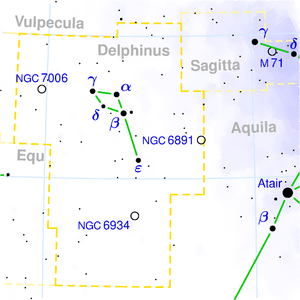
γ1,2 Del - A physical binary star, whose components have apparent magnitudes of 4.3 (yellow) and 5.1 (greenish), are separated by 10" in the sky, so they can be resolved even in a 5 cm telescope. The companion may appear bluish in some eyepieces, which is due to the contrast with the yellow primary component.
Sualocin a Rotanev - The two brightest stars of the constellation, α (3.77 mag) and β Del (3.63 mag), are an example of the unquenchable human desire to leave something lasting behind. If we read the names of these stars backwards, we discover the words Nicolaus Venator, the Latin name of the Palermo astronomer Niccola Cacciatore, a long-time assistant to the famous Italian astronomer Giuseppe Piazzi. He greatly desired for his name to be preserved in the sky. He used a trick and gave his own name to these two stars, even though no one has the right to name a star after themselves. However, this lie was discovered too late, and the names had already become established. Even today, some atlases list them as names of unknown origin. They are the only stars in the sky that bear the name of a real person.
Nova Delphini 1967 - The constellation was made famous by a nova discovered on July 8, 1967 by English teacher and amateur astronomers G. Alcock, who also discovered the Nova Vulpeculae in 1968. This peculiar nova gradually brightened and became visible to the naked eye, then its brightness irregularly fluctuated and weakened again in December 1967. According to records, it is the "slowest nova". Its current magnitude is approximately 12.7mag, making it visible with a slightly larger amateur telescope.
NGC 6934
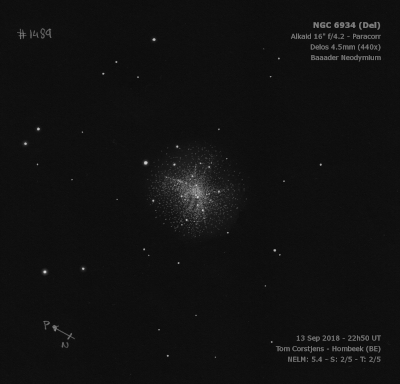
William Herschel discovered NGC 6934 = H I-103 = h2081 on 24 Sep 1785 (sweep 440) and recorded "vB, L, gmbM, er. A beautiful object." His position is 36 sec of RA too far west and 7' too far north. The large error was apparently the result of using "a new Polar distance machine contrived to shew the polar distance of the tube in every situation" that was not finished. JH called it "A beautiful, v compressed, B, R, globular cluster, 3' diam, well resolved. Stars = 16...20m." On 19 Aug 1855, R.J. Mitchell (LdR's assistant) recorded "very fine glob Cl, comes up to a blaze in centre. From f side of Nucl a stream of stars runs np, rather brighter and more condensed than in the rest of the border."
200/250mm - 8" (6/29/84): mottled, fainter halo, clumpy at 400x but no resolution.
300/350mm - 13.1" (6/29/84): fairly bright, moderately large, bright core, small outer halo resolved into approximately 15 stars mainly south of the core, mottled. A mag 9 star is 2' W.
400/500mm - 17.5" (8/5/94): bright, 3.0' diameter, round. Fairly sharp concentration with a 1.5' diameter very bright core. The halo has about two dozen stars peppered in the outer regions; the brightest star is on the NE side of the core. The core is very lively and just starts to break up in to several very faint stars and a single obvious star. A mag 9.5 star is just 2' W of center.
17.5" (7/9/94): bright, fairly small, 3.5' diameter, very bright core. At 225x, 20-25 stars are resolved in the halo mostly in the southern portion. Contains an intense 1.5' core with a much fainter halo to 3.5' which extends almost to a mag 9.5 star 2' W of center. The bright core itself is very lively and mottled with a few faint stars resolved and a single brighter star just east of the geometric center.
Notes by Steve Gottlieb
NGC 6905
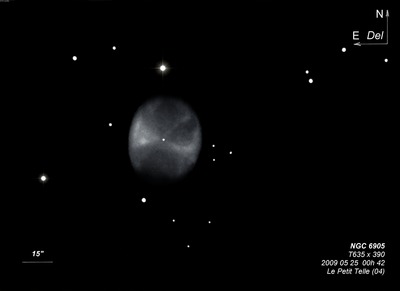
William Herschel discovered NGC 6905 = H IV-16 = h2075 on 16 Sep 1784 (sweep 275) and recorded "pB, perfectly R, pretty well defined, about 3' in diameter." The next night he noted "I do not doubt but it consists of very much compressed stars." His size estimate was much too large, but his position is just 6 seconds too far west. JH made 3 observations and logged on sweep 364, "Fine planetary nebula; B; exactly R; rather hazy at the edges, but not materially brighter in the middle, but no hollow. It has four small stars near it like satellites." The nearby stars were micrometrically measured as the possibility of physical satellites of planetaries intrigued JH and he mentioned it regarding NGC 6818 and 7662.
On 10 Aug 1850 Lord Rosse's assistant reported, "* or B nucl nf the middle. A dark curved line p[receding] this plainly seen, which at moments I fancied went round the sf part". Two years later, George Johnstone Stoney stated "this planetary nebela is a beautiful little spiral". This is a case of imagined spiral structure as it was a primary focus at Birr Castle. R.J. Mitchell's sketch from 12 Aug 1855 with a spiral appearance was included in the 1861 publication (Plate XXVIII, figure 34). Father Secchi noted a bi-polar brightening or mottling, particularly on the east side (1856, 9.5" refractor). Vogel made an excellent sketch of the planetary in Sep 1883 with the 27" Vienna refractor with a dark lane oriented ~N-S, tapering towards the central star and two brighter triangular "wings" on the east and west side, with the eastern wing more prominent.
Based on Crossley photographs taken at Lick, Heber Curtis (1918) reported "the main portion is a very patchy truncated ellipse 44"x37" in p.a. 163°. Very faint cone-shaped ansae extend from each end. A star of mag 12 lies nearly at the end of the southern ansa."
John Mallas coined the nickname "Blue Flash" in his Aug/Sep 1963 article "Visual Atlas of Planetary Nebulae-VI", published in the "Review of Popular Astronomy". He described NGC 6905 as "The Blue Flash. After turning a telescope on this object one will notice the small triangle of stars superimposed upon it. Glimmering and flashing between the triangle is the little planetary. Using about 120x on a 4-inch reveals all that can be seen in small apertures."
200/250mm - 8" (6/29/84): moderately bright, uniform, slightly elongated N-S, two stars at the northeast and south edge.
400/500mm - 17.5" (8/31/86): very pretty planetary at 280x. Fairly bright, fairly small, slightly elongated. A very faint central star (V = 15.7) is visible. Takes 440x well. Just off the north edge is a mag 11 star 1.4' from center and a mag 12 star is just off the south edge 39" from center.
600/800mm - 24" (8/14/15): the "Blue Flash" planetary was observed at 500x and 750x in excellent seeing. The main body is oval 5:4 NNW-SSE, ~48"x40" and annular. The rim appeared brightest along a thin strip on the east side and enhanced in a slightly brighter triangular wedge (roughly 60°-80°) extending east from the mag 15.7 central star. The opposite western rim was also brighter, but the north and south ends as not enhanced. The interior was mottled with a slightly darker, irregular central "hole", particularly on the south and west side of the central star, but not to the east. Mag 10.4 HD 352100 lies 48" N of center and a mag 12 star is 38" SSE of center, in the direction of the major axis.
An extremely faint outer halo or wing was occasionally glimpsed off the north-northwest end, tapering in the direction of the major axis and extending 10"-12" in length. The corresponding extension off the south-southeast side and ending at the mag 12 star (completing a lens-shaped outline out of a truncated ellipse on deep images) was not seen, although Jimi Lowrey felt it was equally visible.
900/1200mm - 48" (5/16/12): beautiful blue oval planetary with a fairly bright central star. Very nice annular appearance with an irregular darker interior. A bright arc is along the east or northeast rim and a slightly weaker counterpart was on the west or southwest edge. The ends are somewhat chopped off, creating a rectangular appearance.
Notes by Steve Gottlieb
NGC 7006
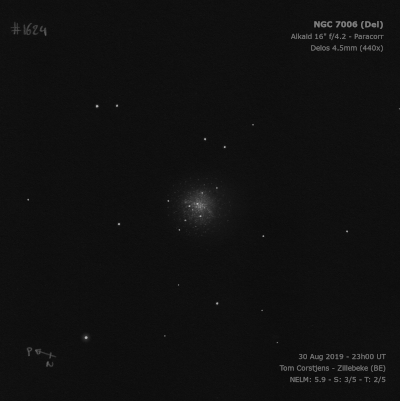
William Herschel discovered NGC 7006 = H I-52 = h2097 on 21 Aug 1784 (sweep 253) and recorded "pB, iR, easily resolvable, about 1' diam. Hazy, otherwise I suppose I might see the stars in it." On 16 Oct 1784 (sweep 294), he logged "vB, R, mbM, the brightness extending a good way, resolvable (see 253 sweep)." John Herschel made the single observation "B; R; gbM; 60". RA from working list, no transit being procured."
300/350mm - 13.1" (6/29/84): fairly faint, small, small bright nucleus, small fainter halo. Mottled and clumpy but not resolved at 360x.
400/500mm - 17.5" (8/5/94): moderately bright, small, 1.5' diameter containing a 1' core and a small halo. The core has a broad weak concentration with no nucleus. The halo is mottled but difficult to achieve clear resolution. Around the edges of the halo four or five mag 15.5 stars or fainter pop in and out of view. The easiest resolved star is just at the north edge of the halo, a close pair is at the east edge and a single star is at the southeast side. An easy pair of mag 14 foreground stars at 20" separation is off the south side 1.6' from the center. The interacting system UGC 11672 lies 43' E.
600/800mm - 24" (7/11/18): at 375x; bright, very bright mottled core with half-dozen very faint stars resolved around the edges of the halo. Three very faint to extremely faint galaxies lies to the southwest; CGCG 448-030 3.6' WSW, LEDA 1501723 6' WSW and CGCG 448-029 7.4' SW.
Notes by Steve Gottlieb
NGC 6891
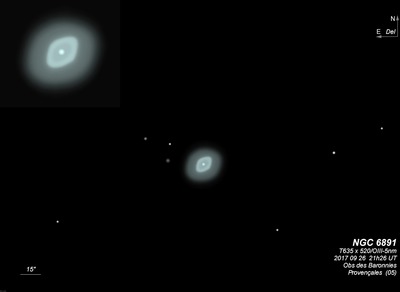
80mm (9/10/07): visible as a faint "star" at 12.5x in the 80mm finder and easy to verify as a planetary by blinking with an OIII filter.
Ralph Copeland discovered NGC 6891 on 22 Sep 1884 at Dun Echt, Scotland, using a direct vision objective-prism (Secchi prism) sweep with a 6.1-inch refractor. He remarked "this seems to be identical with the 9.5 mag star DM +12°4266. It is in reality a planetary nebula about 4" in diameter with a nearly monochromatic spectrum."
Based on Crossley photographs taken at Lick, Heber Curtis (1918) noted, "mag 11.8 central star (Burnham). A round disk 15" in diameter, of which the central 7" is considerably the brighter. From this brighter center extend indistinct traces of wings in p.a. about 135-315°."
200/250mm - 8" (6/29/84): fairly high surface brightness, small blue disk.
400/500mm - 17.5" (8/27/87): very bright at 140x and OIII filter. Appears as a small high surface brightness bluish oval of 10"-15" diameter. At 410x, a brighter center or mag 13 central star is visible. At this magnification, the planetary appears as a bright oval with a fainter outer halo.
600/800mm - 24" (7/1/16): at 375x; very bright bluish disc slightly elongated NNW-SSE, perhaps 10"x8". A fainter outer halo increases the diameter to roughly 18". The mag 12.5-13 central star was steadily visible. A mag 14.5 star is close off the NE edge [17" from center]. At 750x the brighter inner disc seemed more elongated with tapered ends like a lens.
Notes by Steve Gottlieb
NGC 6928
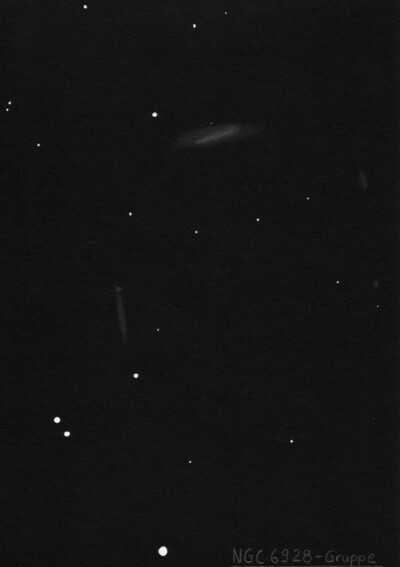
200/250mm - 8" (8/12/83): extremely faint, averted only, elongated ~E-W, small bright nucleus?, fairly bright wide double star in field to NW.
300/350mm - 13.1" (6/29/84): fairly faint, elongated E-W. An extremely faint star is at the north edge.
400/500mm - 17.5" (9/14/85): moderately bright, pretty edge-on WNW-ESE, bright core. A mag 13 star is superimposed north of the core just 20" from center. Brightest in a group with NGC 6927 3' WSW and NGC 6930 4' SE.
600/800mm - 24" (9/25/19): at 375x; moderately bright and large, very elongated 4:1 WNW-ESE, 1.2'x0.3', bright core. A mag 13.5 star is close north [15" from center of the galaxy].
Notes by Steve Gottlieb
NGC 6956
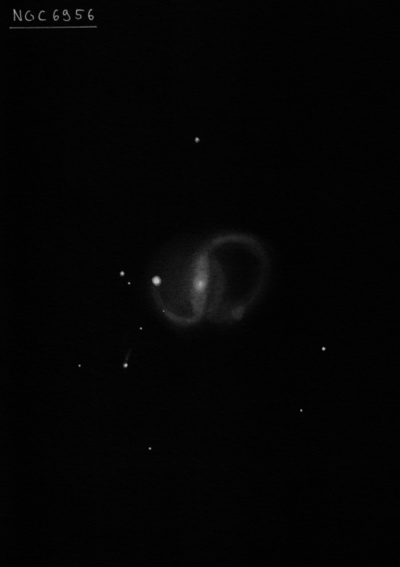
William Herschel discovered NGC 6956 = H III-219 = h2086 on 19 Oct 1784 (sweep 299) and noted "eF; vS; stellar; just preceding a small star, 240 verified it with difficulty." JH made a single observation and recorded "vF; S; 15" precedes and is attached to the double star No. 1566 of my 4th catalogue." His position for HJ 1566 matches the two stars mentioned in my 24" observation, altlhough the WDS identifies a pair that is off the east side of UGC 11620.
200/250mm - 8" (7/16/82): faint, small. A mag 10 star at the east edge interferes.
300/350mm - 13" (6/29/84): faint, diffuse, even surface brightness, possibly slightly elongated E-W. A mag 10.5 star is attached at the east edge 26" from center and detracts from viewing. Brightest of three with UGC 11620 6.7' SSE and UGC 11623 8.0' E.
400/500mm - 17.5" (10/13/01): this moderately bright glow appears unusual as a mag 10.5 star is attached at the east side and interferes with viewing. The surface brightness of this barred spiral is pretty uniform except for a faint stellar nucleus. A mag 14 companion star (double) follows the brighter star. Brightest in a trio with UGC 11620 and 11623 situated 7' SSE and 8' ESE, respectively.
600/800mm - 24" (8/5/13): moderately bright to fairly bright, moderately large, elongated ~3:2 NW-SE, 60"x40". The view is somewhat hampered by a mag 11 star that is superimposed on the east edge and a mag 14.5 star is ~20" E of the bright star. This galaxy appears to be a barred spiral with a brighter bar oriented ~N-S extending down the middle of the glow. The brighter nucleus is quasi-stellar (~5") and similar to the mag 14.5 star in brightness. A faint extension (spiral arm) curves east from the south end of the bar, extending south of the mag 11 star. Brightest in a trio (KTG 71) with UGC 11620 6.9' SE and UGC 11623 8.1' E. Located in a rich Milky Way star field 3.7' SSW of a mag 9.6 star. UGC 11620 appeared faint/fairly faint, small, elongated 3:2 SSW-NNE, 21"x14". Two mag 13/14 stars are off the SE end and a mag 15.5 star is near the NNE end [22" from center]. UGC 11623 is fairly faint, fairly small, elongated 5:3 SW-NE, 36"x20", a small brighter core is embedded in a fairly smooth halo. A small trio of mag 13/14.5.15 stars is close preceding.
Notes by Steve Gottlieb
NGC 7025
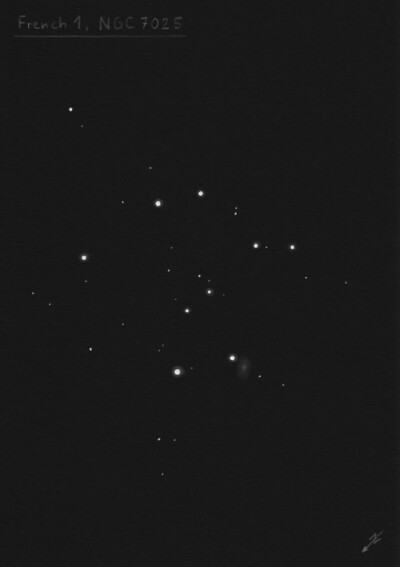
Albert Marth discovered NGC 7025 = m 433 on 17 Sep 1863 and noted "vF, vS, R, stell." His position is accurate.
300/350mm - 13.1" (9/29/84): fairly faint, very small, almost round, small bright nucleus. Located close following a large, scattered group of bright mag 8-10 stars (dubbed the "Toadstool" by Sue French) and just 0.7' E of a mag 9.5 star!
400/500mm - 18" (10/8/05): fairly faint, fairly small, slightly elongated SW-NE, 0.8'x0.6', sharply concentrated with a well-defined bright core and a faint halo. The core brightness somewhat to the center. Located 40" E of a mag 9.7 star, which is on the east edge of a bright, scattered group of stars ("Toadstool" or French 1).
Notes by Steve Gottlieb
UGC 11564
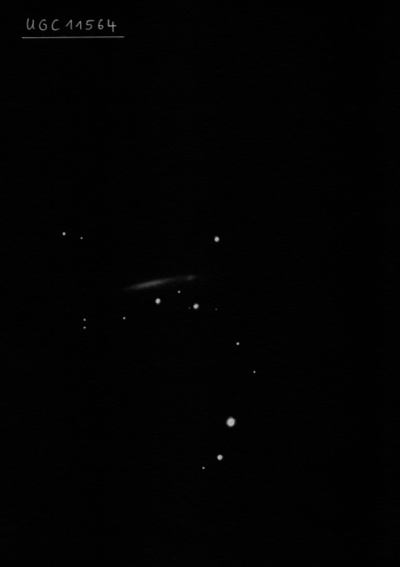
UGC 11564 is a close pair of galaxies, though the fainter companion on the west end was not resolved. Listed in VV Part II under "parallel flat systems".
600/800mm - 24" (9/1/16): at 220x; extremely faint, fairly small, very elongated 3:1 WNW-ESE, 30"x10", very low surface brightness. A mag 13.5 star is at the south edge and a mag 12.5 star is 50" SW. First in a group of 4 UGC galaxies with UGC 11568 9.6' E.
Notes by Steve Gottlieb
Abell 72
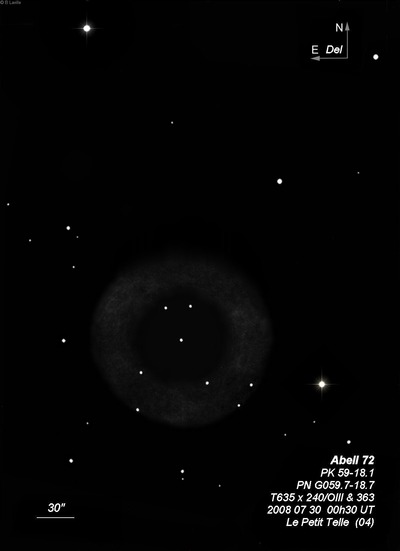
| Type | PN [3b] |
| RA | 20:50:02.1 |
| Dec | +13:33:30.0 |
| major_axis | 2.0' |
| minor_axis | 1.8' |
| mag | 14.6 |
| surface_bright | 15.7 |